Case Study: Macroeconomic Challenges in the US Economy - ECON 101
VerifiedAdded on 2022/10/19
|8
|969
|5
Case Study
AI Summary
This case study analyzes the macroeconomic challenges of unemployment and inflation in the US economy. It highlights the higher unemployment rates among young college graduates and Black and Hispanic communities compared to national averages. The analysis includes data on unemployment and inflation trends from 2009 to 2019, referencing sources like Tradingeconomics.com, BEA.gov, and Statista.com. The study further explores the impact of these issues on social inclusion and economic disparity. Proposed solutions involve balanced employment protection, remedial programs, monetary policies, and labor market adjustments to transition unemployed individuals to self-employment. The assignment references multiple academic sources to support its findings and recommendations, providing a comprehensive overview of the challenges and potential strategies for improvement.
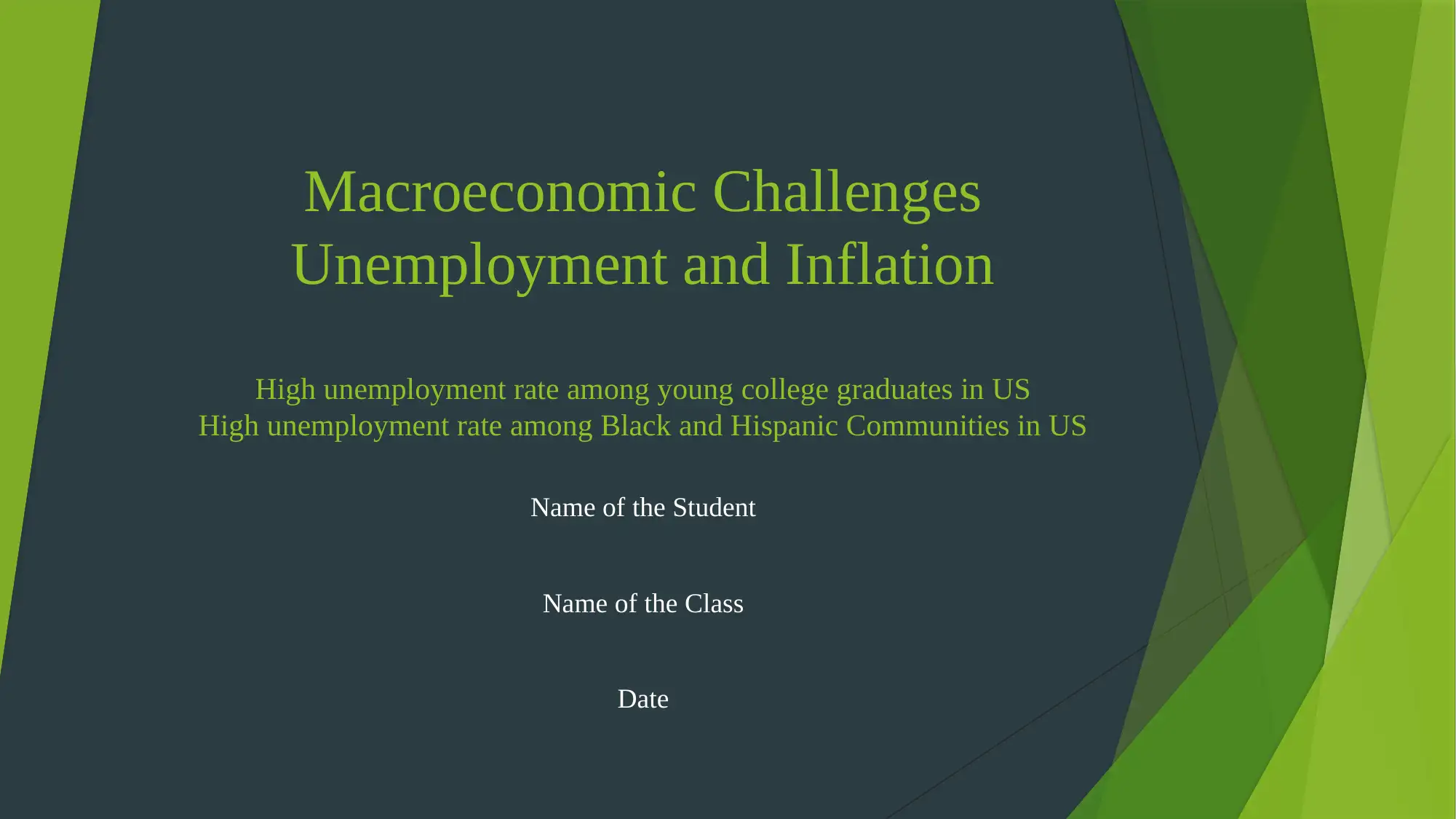
Macroeconomic Challenges
Unemployment and Inflation
High unemployment rate among young college graduates in US
High unemployment rate among Black and Hispanic Communities in US
Name of the Student
Name of the Class
Date
Unemployment and Inflation
High unemployment rate among young college graduates in US
High unemployment rate among Black and Hispanic Communities in US
Name of the Student
Name of the Class
Date
Paraphrase This Document
Need a fresh take? Get an instant paraphrase of this document with our AI Paraphraser
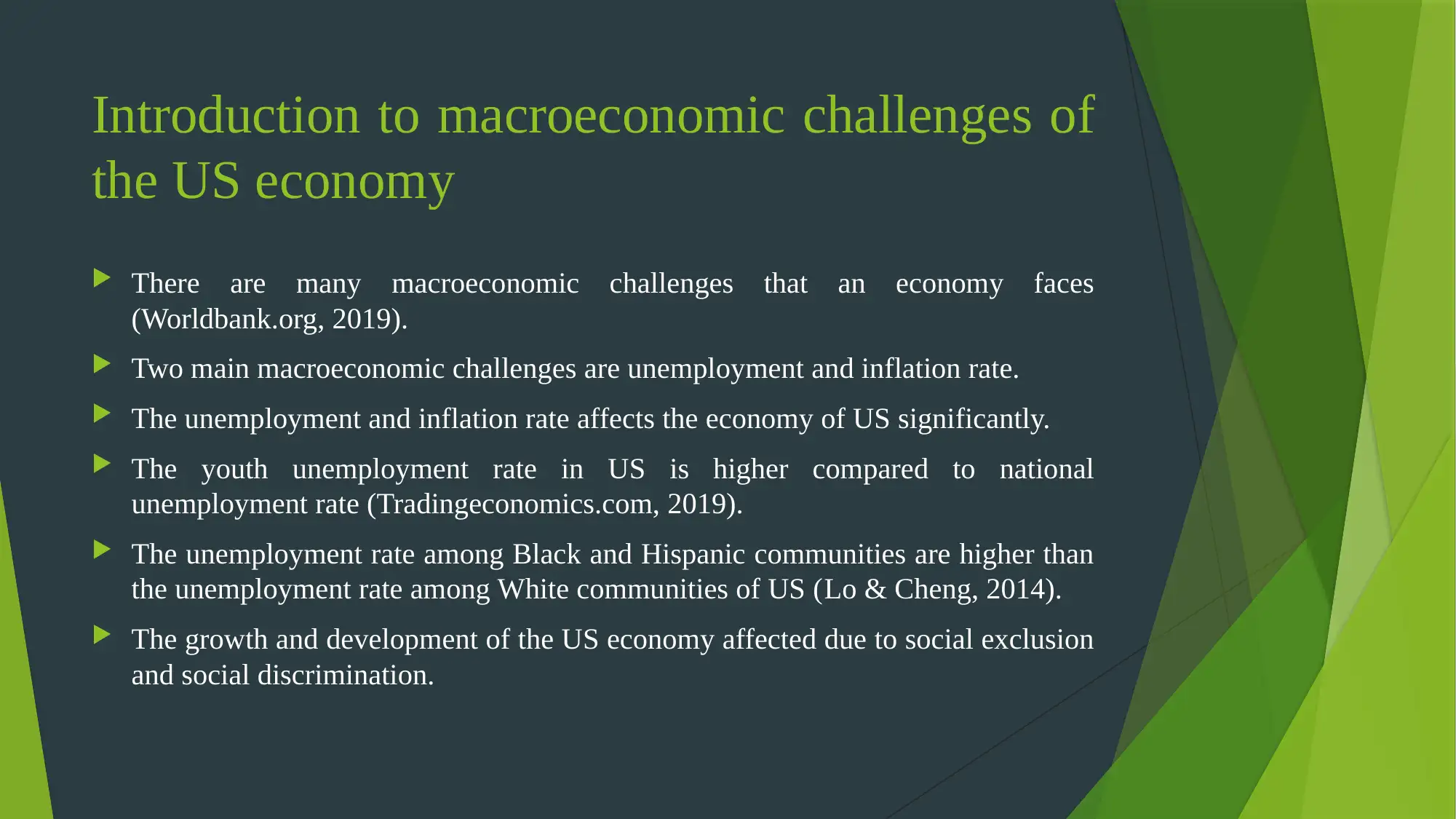
Introduction to macroeconomic challenges of
the US economy
There are many macroeconomic challenges that an economy faces
(Worldbank.org, 2019).
Two main macroeconomic challenges are unemployment and inflation rate.
The unemployment and inflation rate affects the economy of US significantly.
The youth unemployment rate in US is higher compared to national
unemployment rate (Tradingeconomics.com, 2019).
The unemployment rate among Black and Hispanic communities are higher than
the unemployment rate among White communities of US (Lo & Cheng, 2014).
The growth and development of the US economy affected due to social exclusion
and social discrimination.
the US economy
There are many macroeconomic challenges that an economy faces
(Worldbank.org, 2019).
Two main macroeconomic challenges are unemployment and inflation rate.
The unemployment and inflation rate affects the economy of US significantly.
The youth unemployment rate in US is higher compared to national
unemployment rate (Tradingeconomics.com, 2019).
The unemployment rate among Black and Hispanic communities are higher than
the unemployment rate among White communities of US (Lo & Cheng, 2014).
The growth and development of the US economy affected due to social exclusion
and social discrimination.
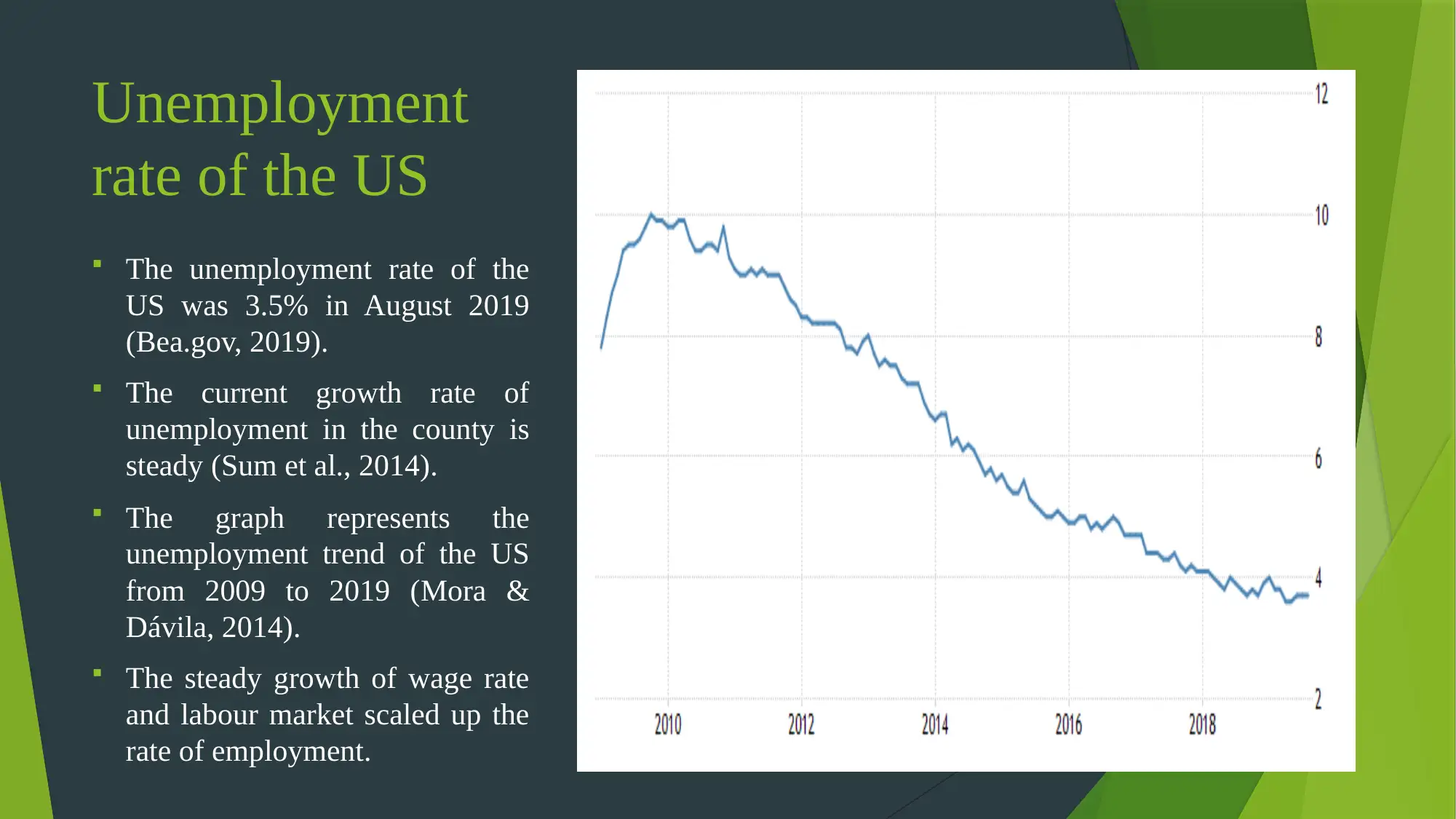
Unemployment
rate of the US
The unemployment rate of the
US was 3.5% in August 2019
(Bea.gov, 2019).
The current growth rate of
unemployment in the county is
steady (Sum et al., 2014).
The graph represents the
unemployment trend of the US
from 2009 to 2019 (Mora &
Dávila, 2014).
The steady growth of wage rate
and labour market scaled up the
rate of employment.
rate of the US
The unemployment rate of the
US was 3.5% in August 2019
(Bea.gov, 2019).
The current growth rate of
unemployment in the county is
steady (Sum et al., 2014).
The graph represents the
unemployment trend of the US
from 2009 to 2019 (Mora &
Dávila, 2014).
The steady growth of wage rate
and labour market scaled up the
rate of employment.
⊘ This is a preview!⊘
Do you want full access?
Subscribe today to unlock all pages.

Trusted by 1+ million students worldwide
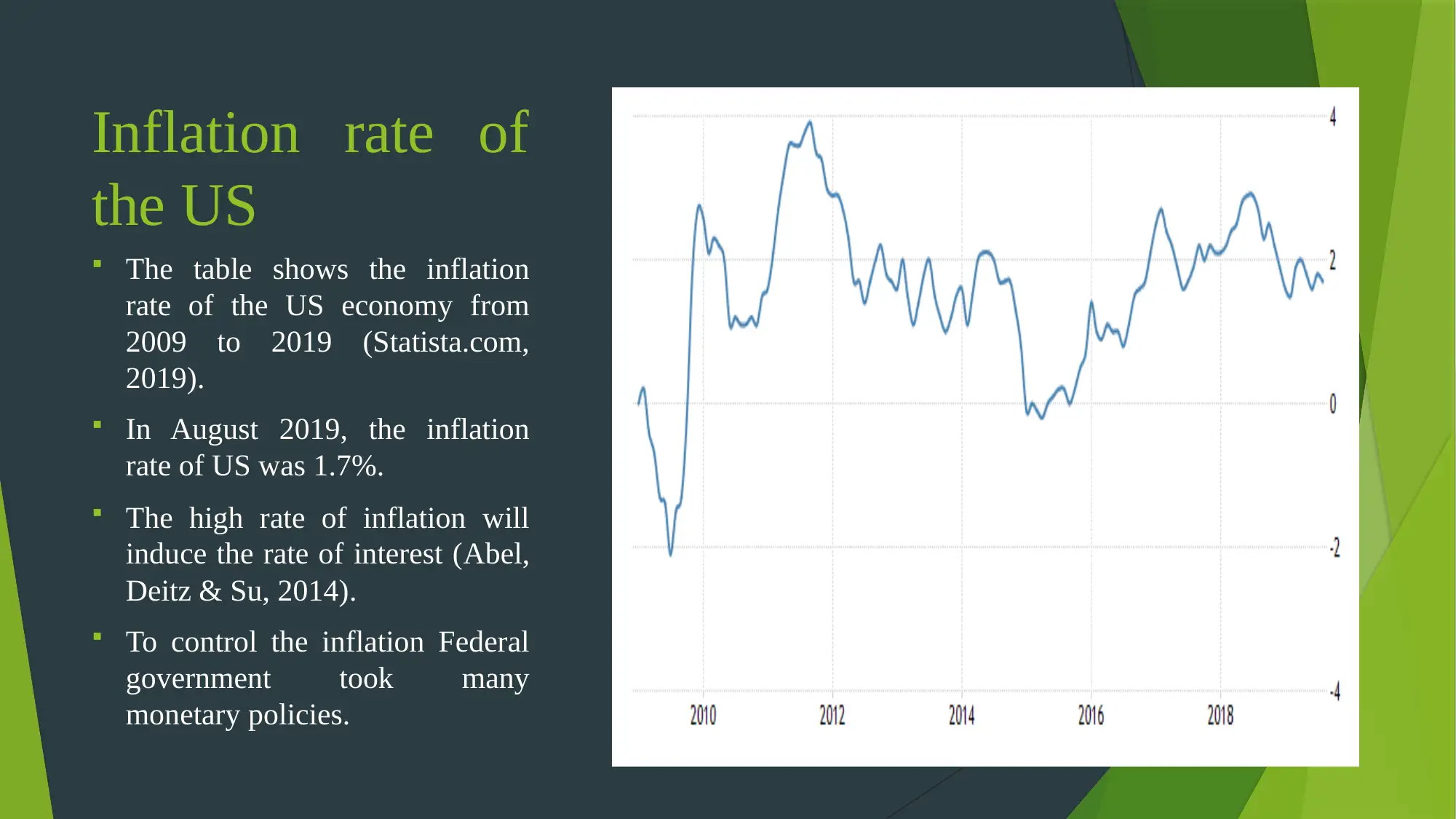
Inflation rate of
the US
The table shows the inflation
rate of the US economy from
2009 to 2019 (Statista.com,
2019).
In August 2019, the inflation
rate of US was 1.7%.
The high rate of inflation will
induce the rate of interest (Abel,
Deitz & Su, 2014).
To control the inflation Federal
government took many
monetary policies.
the US
The table shows the inflation
rate of the US economy from
2009 to 2019 (Statista.com,
2019).
In August 2019, the inflation
rate of US was 1.7%.
The high rate of inflation will
induce the rate of interest (Abel,
Deitz & Su, 2014).
To control the inflation Federal
government took many
monetary policies.
Paraphrase This Document
Need a fresh take? Get an instant paraphrase of this document with our AI Paraphraser
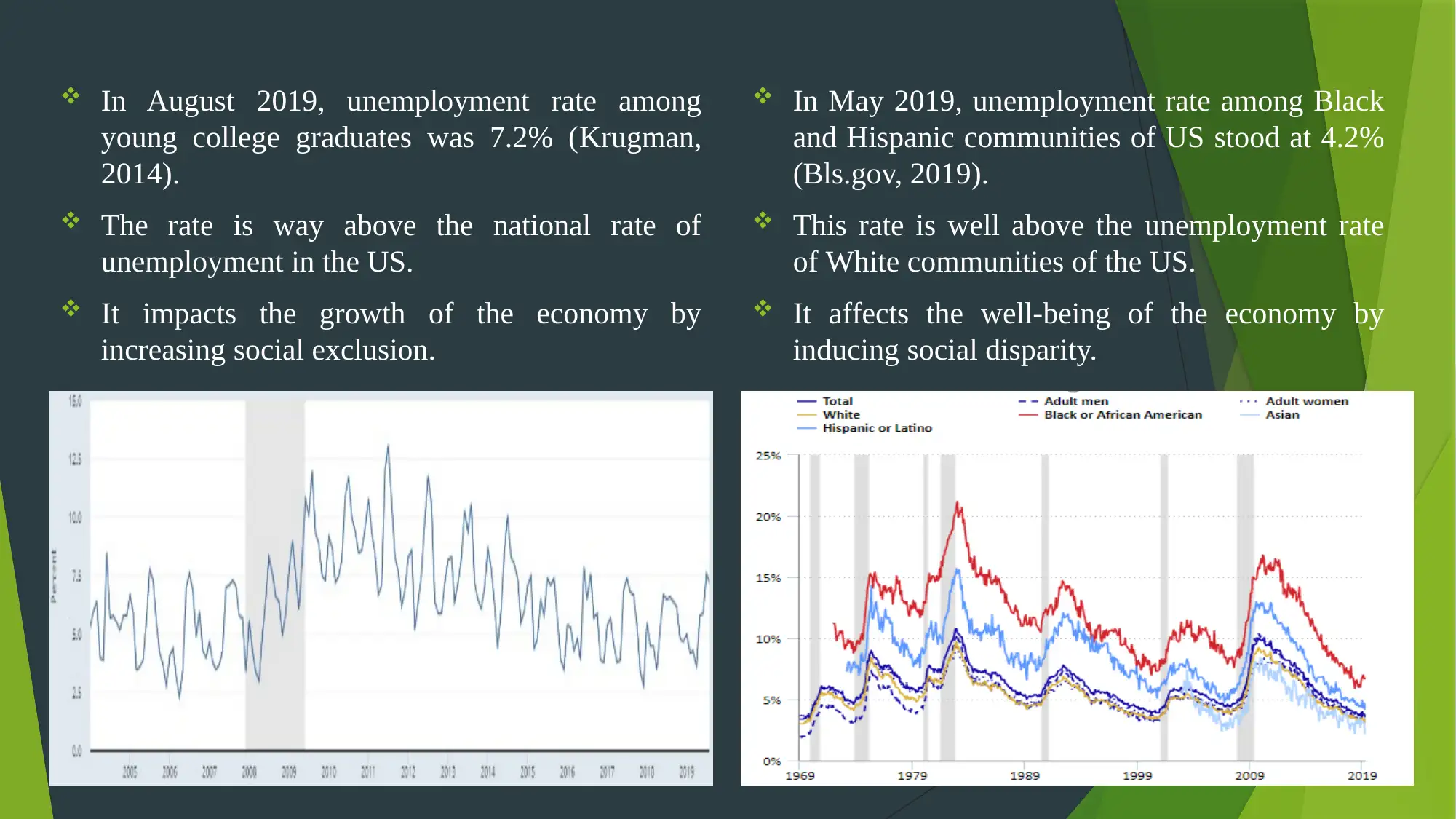
In August 2019, unemployment rate among
young college graduates was 7.2% (Krugman,
2014).
The rate is way above the national rate of
unemployment in the US.
It impacts the growth of the economy by
increasing social exclusion.
In May 2019, unemployment rate among Black
and Hispanic communities of US stood at 4.2%
(Bls.gov, 2019).
This rate is well above the unemployment rate
of White communities of the US.
It affects the well-being of the economy by
inducing social disparity.
young college graduates was 7.2% (Krugman,
2014).
The rate is way above the national rate of
unemployment in the US.
It impacts the growth of the economy by
increasing social exclusion.
In May 2019, unemployment rate among Black
and Hispanic communities of US stood at 4.2%
(Bls.gov, 2019).
This rate is well above the unemployment rate
of White communities of the US.
It affects the well-being of the economy by
inducing social disparity.
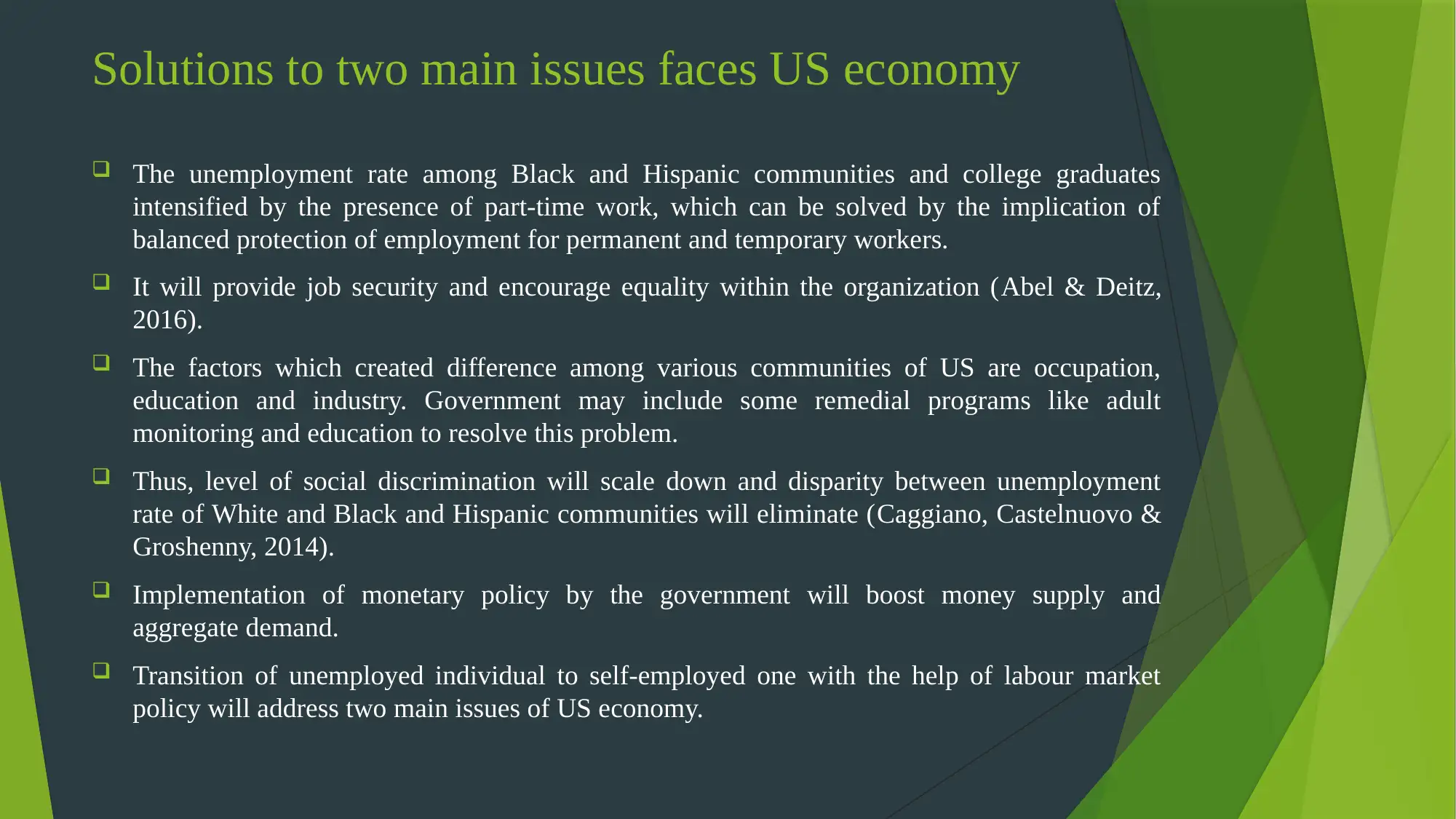
Solutions to two main issues faces US economy
The unemployment rate among Black and Hispanic communities and college graduates
intensified by the presence of part-time work, which can be solved by the implication of
balanced protection of employment for permanent and temporary workers.
It will provide job security and encourage equality within the organization (Abel & Deitz,
2016).
The factors which created difference among various communities of US are occupation,
education and industry. Government may include some remedial programs like adult
monitoring and education to resolve this problem.
Thus, level of social discrimination will scale down and disparity between unemployment
rate of White and Black and Hispanic communities will eliminate (Caggiano, Castelnuovo &
Groshenny, 2014).
Implementation of monetary policy by the government will boost money supply and
aggregate demand.
Transition of unemployed individual to self-employed one with the help of labour market
policy will address two main issues of US economy.
The unemployment rate among Black and Hispanic communities and college graduates
intensified by the presence of part-time work, which can be solved by the implication of
balanced protection of employment for permanent and temporary workers.
It will provide job security and encourage equality within the organization (Abel & Deitz,
2016).
The factors which created difference among various communities of US are occupation,
education and industry. Government may include some remedial programs like adult
monitoring and education to resolve this problem.
Thus, level of social discrimination will scale down and disparity between unemployment
rate of White and Black and Hispanic communities will eliminate (Caggiano, Castelnuovo &
Groshenny, 2014).
Implementation of monetary policy by the government will boost money supply and
aggregate demand.
Transition of unemployed individual to self-employed one with the help of labour market
policy will address two main issues of US economy.
⊘ This is a preview!⊘
Do you want full access?
Subscribe today to unlock all pages.

Trusted by 1+ million students worldwide
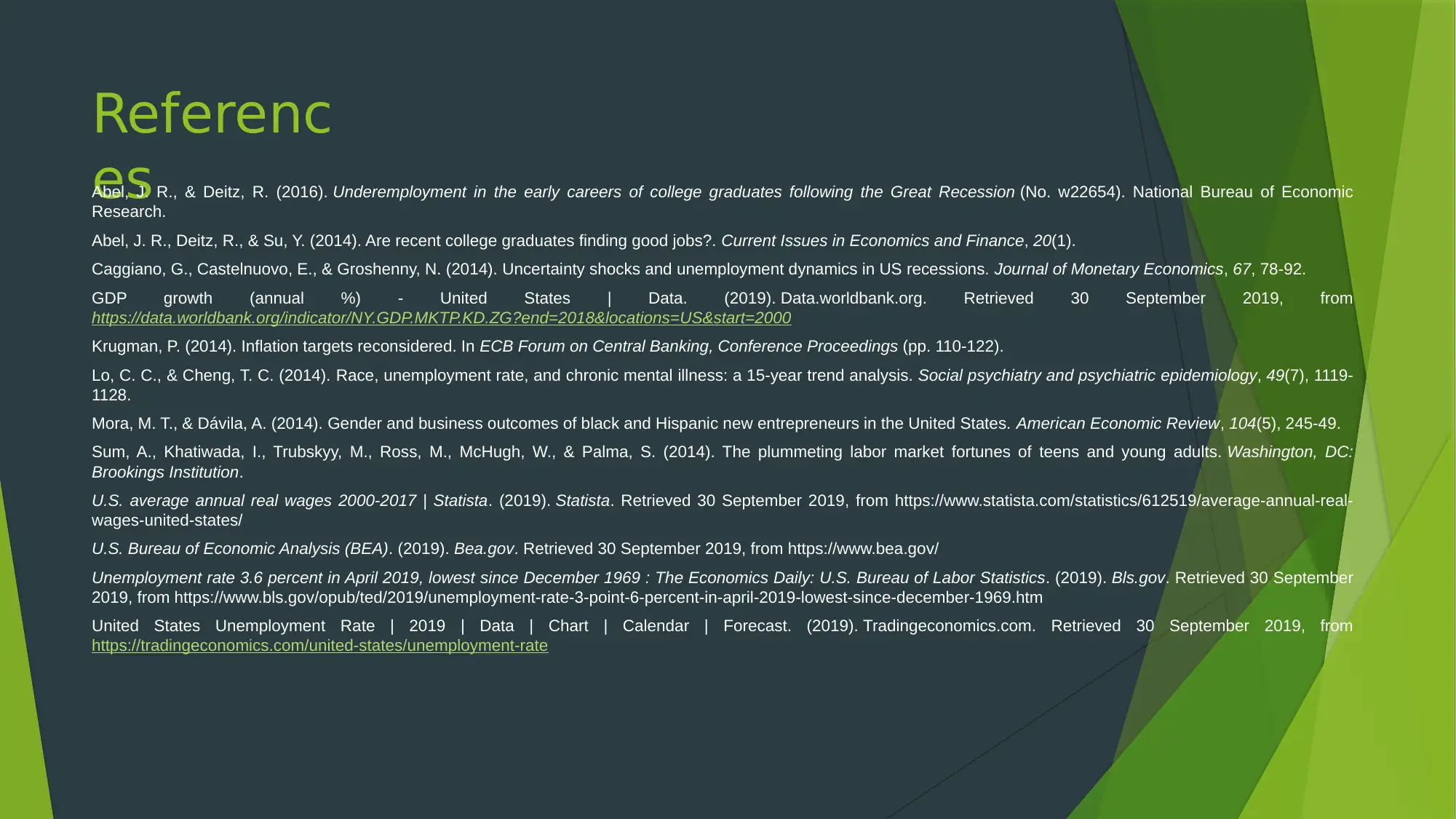
Referenc
esAbel, J. R., & Deitz, R. (2016). Underemployment in the early careers of college graduates following the Great Recession (No. w22654). National Bureau of Economic
Research.
Abel, J. R., Deitz, R., & Su, Y. (2014). Are recent college graduates finding good jobs?. Current Issues in Economics and Finance, 20(1).
Caggiano, G., Castelnuovo, E., & Groshenny, N. (2014). Uncertainty shocks and unemployment dynamics in US recessions. Journal of Monetary Economics, 67, 78-92.
GDP growth (annual %) - United States | Data. (2019). Data.worldbank.org. Retrieved 30 September 2019, from
https://data.worldbank.org/indicator/NY.GDP.MKTP.KD.ZG?end=2018&locations=US&start=2000
Krugman, P. (2014). Inflation targets reconsidered. In ECB Forum on Central Banking, Conference Proceedings (pp. 110-122).
Lo, C. C., & Cheng, T. C. (2014). Race, unemployment rate, and chronic mental illness: a 15-year trend analysis. Social psychiatry and psychiatric epidemiology, 49(7), 1119-
1128.
Mora, M. T., & Dávila, A. (2014). Gender and business outcomes of black and Hispanic new entrepreneurs in the United States. American Economic Review, 104(5), 245-49.
Sum, A., Khatiwada, I., Trubskyy, M., Ross, M., McHugh, W., & Palma, S. (2014). The plummeting labor market fortunes of teens and young adults. Washington, DC:
Brookings Institution.
U.S. average annual real wages 2000-2017 | Statista. (2019). Statista. Retrieved 30 September 2019, from https://www.statista.com/statistics/612519/average-annual-real-
wages-united-states/
U.S. Bureau of Economic Analysis (BEA). (2019). Bea.gov. Retrieved 30 September 2019, from https://www.bea.gov/
Unemployment rate 3.6 percent in April 2019, lowest since December 1969 : The Economics Daily: U.S. Bureau of Labor Statistics. (2019). Bls.gov. Retrieved 30 September
2019, from https://www.bls.gov/opub/ted/2019/unemployment-rate-3-point-6-percent-in-april-2019-lowest-since-december-1969.htm
United States Unemployment Rate | 2019 | Data | Chart | Calendar | Forecast. (2019). Tradingeconomics.com. Retrieved 30 September 2019, from
https://tradingeconomics.com/united-states/unemployment-rate
esAbel, J. R., & Deitz, R. (2016). Underemployment in the early careers of college graduates following the Great Recession (No. w22654). National Bureau of Economic
Research.
Abel, J. R., Deitz, R., & Su, Y. (2014). Are recent college graduates finding good jobs?. Current Issues in Economics and Finance, 20(1).
Caggiano, G., Castelnuovo, E., & Groshenny, N. (2014). Uncertainty shocks and unemployment dynamics in US recessions. Journal of Monetary Economics, 67, 78-92.
GDP growth (annual %) - United States | Data. (2019). Data.worldbank.org. Retrieved 30 September 2019, from
https://data.worldbank.org/indicator/NY.GDP.MKTP.KD.ZG?end=2018&locations=US&start=2000
Krugman, P. (2014). Inflation targets reconsidered. In ECB Forum on Central Banking, Conference Proceedings (pp. 110-122).
Lo, C. C., & Cheng, T. C. (2014). Race, unemployment rate, and chronic mental illness: a 15-year trend analysis. Social psychiatry and psychiatric epidemiology, 49(7), 1119-
1128.
Mora, M. T., & Dávila, A. (2014). Gender and business outcomes of black and Hispanic new entrepreneurs in the United States. American Economic Review, 104(5), 245-49.
Sum, A., Khatiwada, I., Trubskyy, M., Ross, M., McHugh, W., & Palma, S. (2014). The plummeting labor market fortunes of teens and young adults. Washington, DC:
Brookings Institution.
U.S. average annual real wages 2000-2017 | Statista. (2019). Statista. Retrieved 30 September 2019, from https://www.statista.com/statistics/612519/average-annual-real-
wages-united-states/
U.S. Bureau of Economic Analysis (BEA). (2019). Bea.gov. Retrieved 30 September 2019, from https://www.bea.gov/
Unemployment rate 3.6 percent in April 2019, lowest since December 1969 : The Economics Daily: U.S. Bureau of Labor Statistics. (2019). Bls.gov. Retrieved 30 September
2019, from https://www.bls.gov/opub/ted/2019/unemployment-rate-3-point-6-percent-in-april-2019-lowest-since-december-1969.htm
United States Unemployment Rate | 2019 | Data | Chart | Calendar | Forecast. (2019). Tradingeconomics.com. Retrieved 30 September 2019, from
https://tradingeconomics.com/united-states/unemployment-rate
Paraphrase This Document
Need a fresh take? Get an instant paraphrase of this document with our AI Paraphraser

1 out of 8
Related Documents
Your All-in-One AI-Powered Toolkit for Academic Success.
+13062052269
info@desklib.com
Available 24*7 on WhatsApp / Email
![[object Object]](/_next/static/media/star-bottom.7253800d.svg)
Unlock your academic potential
Copyright © 2020–2025 A2Z Services. All Rights Reserved. Developed and managed by ZUCOL.





